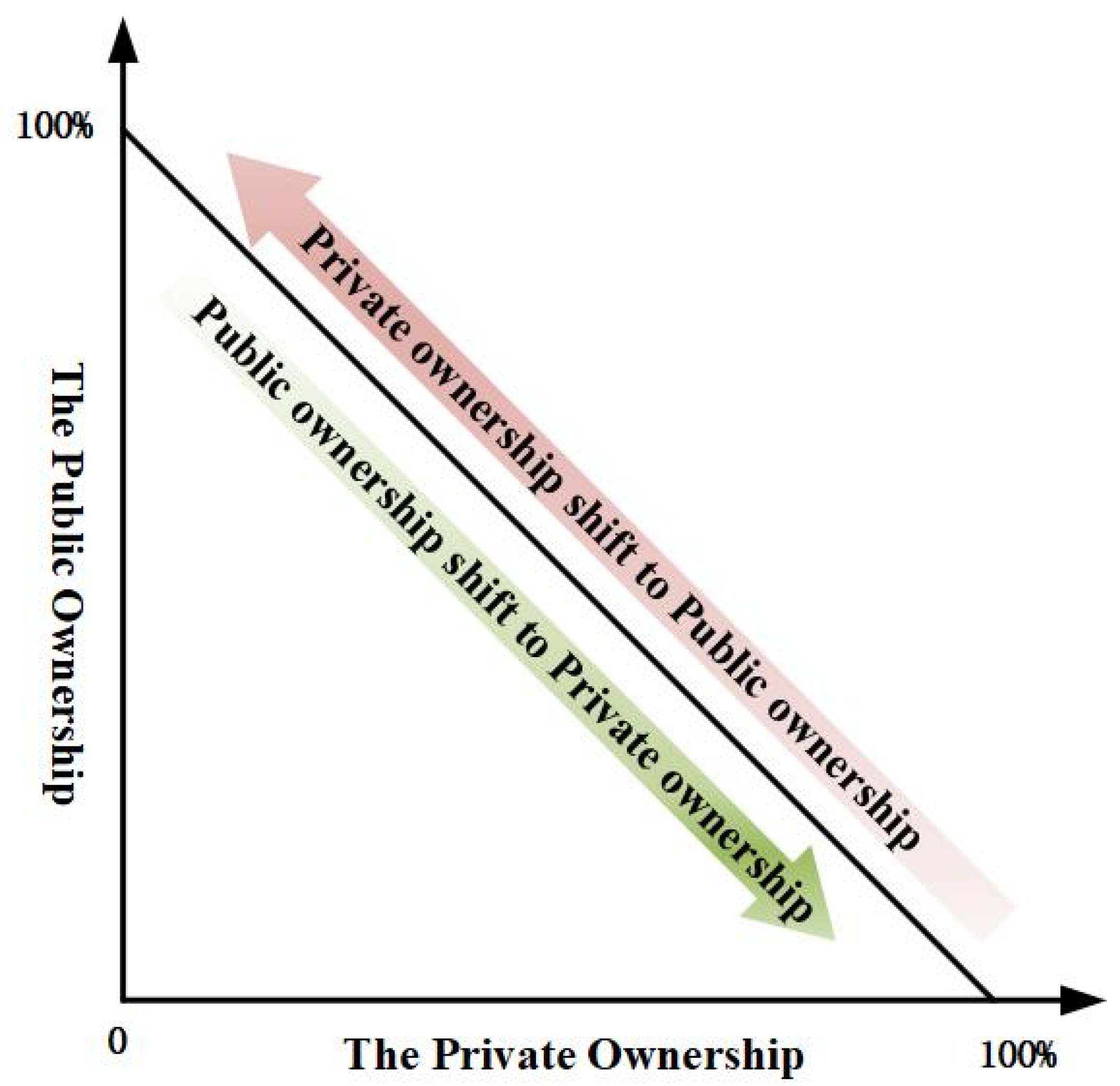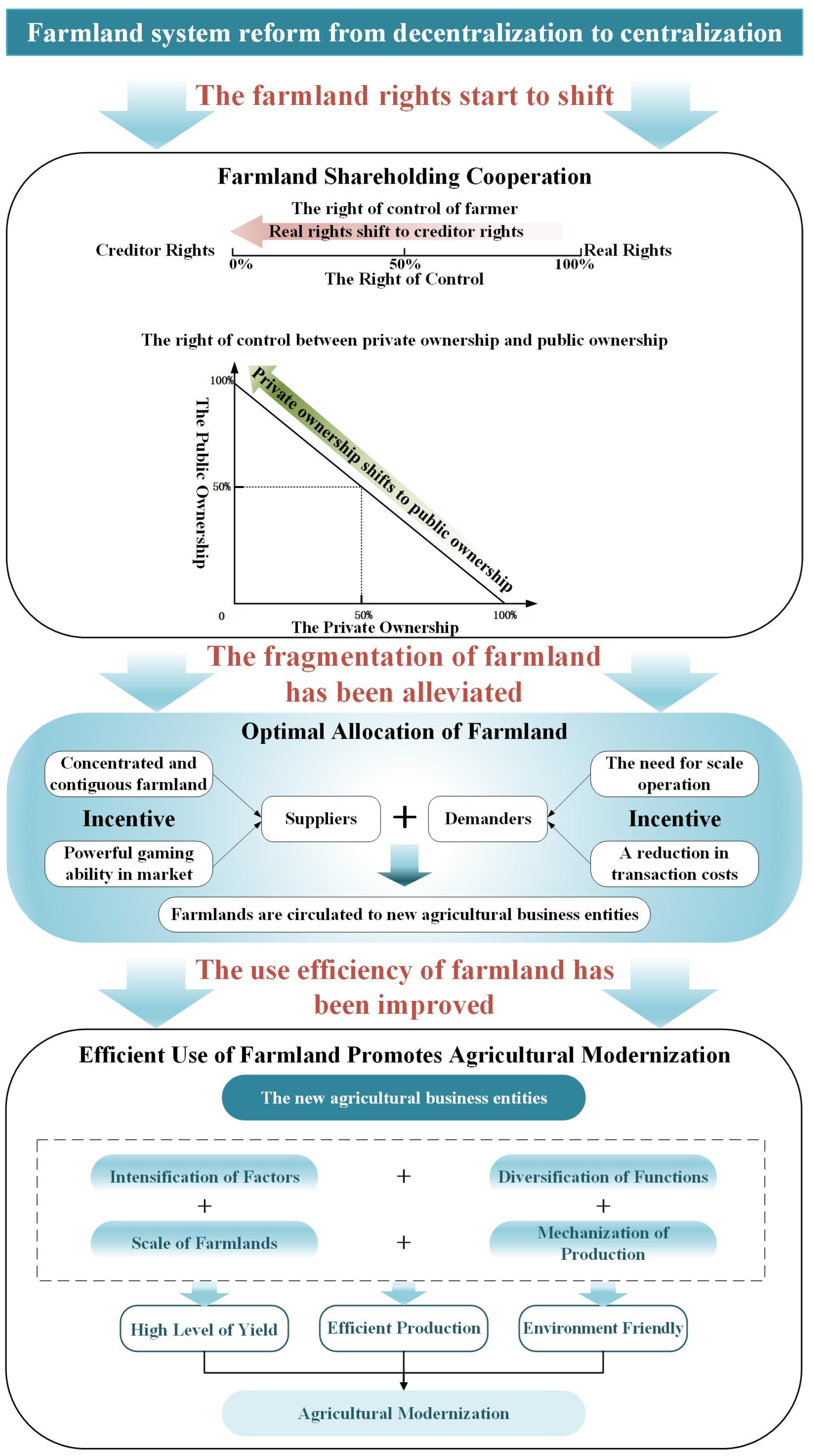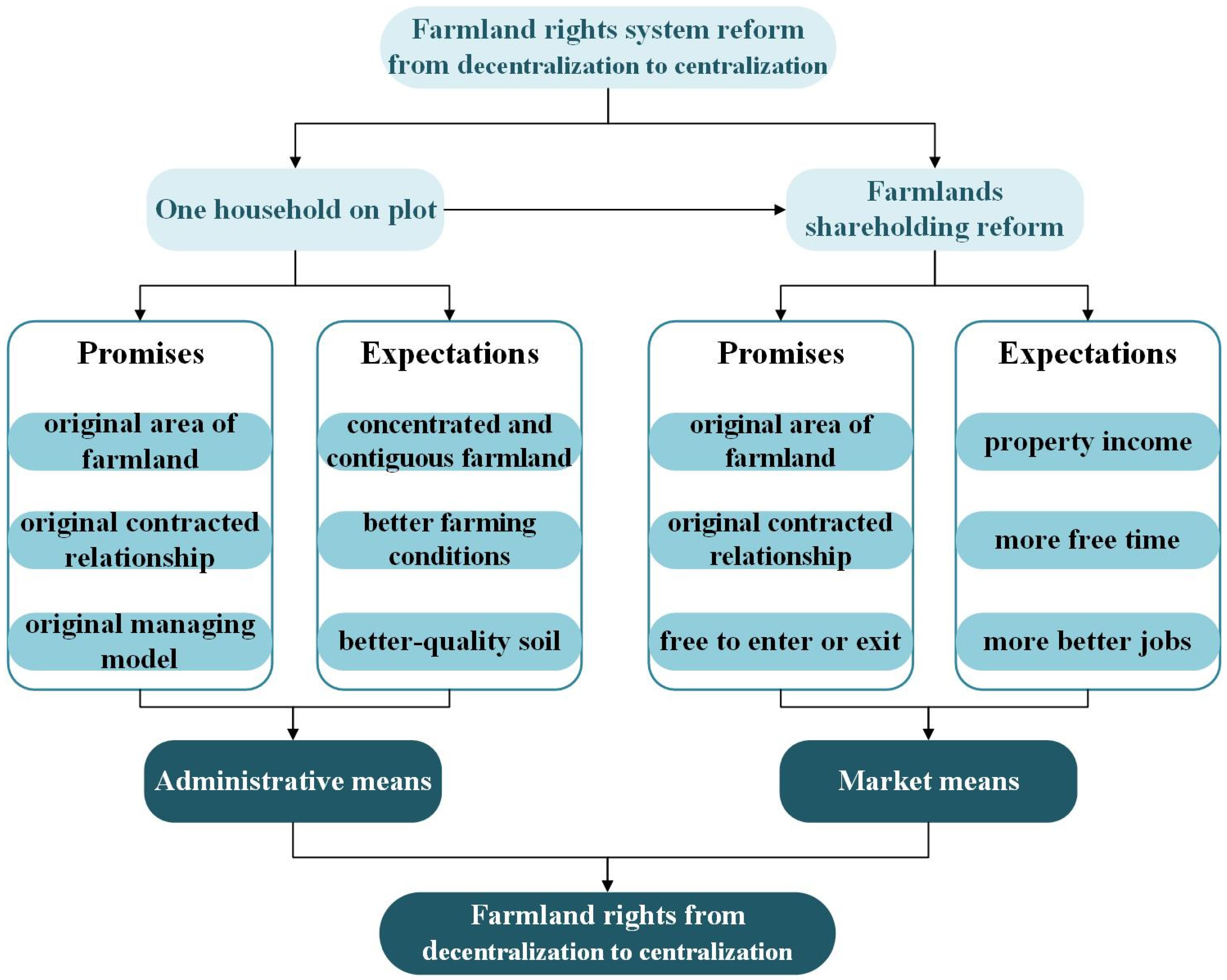The Theoretical Approach and Practice of Farmland Rights System Reform from Decentralization to Centralization Promoting Agricultural Modernization: Evidence from Yuyang District in Shaanxi, China
Abstract
1. Introduction
2. Theoretical Approach, Methodology and Data Sources
2.1. The Theoretical Approach Based on the Shift Theory of Land Rights
2.2. Indicators Selection of Evaluating Reform Performance
2.3. The Methodology and Data Sources
3. The Practice of The Farmland Rights System Reform in Yuyang District
3.1. The General Situation of Yuyang District
3.2. The Farmland Rights System Reform from Decentralization to Centralization in Yuyang District
3.3. The Development of Agricultural Modernization in Yuyang District after Farmland Rights System Reform
4. The Farmland Rights System Reform Performance of Yuyang District
4.1. High Level of Yield
4.2. Efficient Production
4.3. Environmental Friendliness
5. Discussion and Implications
5.1. Discussion
5.2. Implications
6. Conclusions
Author Contributions
Funding
Informed Consent Statement
Data Availability Statement
Conflicts of Interest
| 1 | Mu is a unit of area, which is equal to 0.0667 hectares. |
| 2 | Yuan refers to the currency unit of RMB. |
References
- Ye, J. Land Transfer and the Pursuit of Agricultural Modernization in China. J. Agrar. Chang 2015, 15, 314–337. [Google Scholar] [CrossRef]
- Guo, Y.; Liu, Y. Poverty alleviation through land assetization and its implications for rural revitalization in China. Land Use Policy 2021, 105, 105418. [Google Scholar] [CrossRef]
- Zhou, Y.; Li, X.; Liu, Y. Rural land system reforms in China: History, issues, measures and prospects. Land Use Policy 2020, 91, 104330. [Google Scholar] [CrossRef]
- Jiang, H.; Tian, S.; Chen, L. Research on the reform of market-oriented allocation of land factors in the new era based on consensus perspective. Issues Agric. Econ. 2022, 2, 70–84. [Google Scholar]
- Kan, K. Creating land markets for rural revitalization: Land transfer, property rights and gentrification in China. J. Rural Stud. 2021, 81, 68–77. [Google Scholar] [CrossRef]
- Li, Y.; Liu, Y.; Long, H.; Cui, W. Community-based rural residential land consolidation and allocation can help to revitalize hollowed villages in traditional agricultural areas of China: Evidence from Dancheng County, Henan Province. Land Use Policy 2014, 39, 188–198. [Google Scholar] [CrossRef]
- Wang, W. Short-term or long-term? New insights into rural collectives’ perceptions of Land Value Capture within China’s rural land marketization reform. J. Rural Stud. 2022, 89, 87–97. [Google Scholar] [CrossRef]
- Qian, Z.; Mu, Y. Path selection of rural revitalization and the further reform of rural land institution. Issues Agric. Econ. 2020, 4, 28–36. [Google Scholar]
- Gao, J.; Liu, Y.; Chen, J. China’s initiatives towards rural land system reform. Land Use Policy 2020, 94, 104567. [Google Scholar] [CrossRef]
- Zhou, C.; Liang, Y.; Fuller, A. Tracing agricultural land transfer in China: Some legal and policy issues. Land 2021, 10, 58. [Google Scholar] [CrossRef]
- Liu, Y.; Zang, Y.; Yang, Y. China’s rural revitalization and development: Theory, technology and management. J. Geogr. Sci. 2020, 30, 1923–1942. [Google Scholar] [CrossRef]
- Wang, Q.; Zhang, X. Three rights separation: China’s proposed rural land rights reform and four types of local trials. Land Use Policy 2017, 63, 111–121. [Google Scholar] [CrossRef]
- Han, C. The reform of China’s rural land system. Issues Agric. Econ. 2019, 1, 4–16. [Google Scholar]
- Xu, Y.; Huang, X.; Bao, H.X.; Ju, X.; Zhong, T.; Chen, Z.; Zhou, Y. Rural land rights reform and agro-environmental sustainability: Empirical evidence from China. Land Use Policy 2018, 74, 73–87. [Google Scholar] [CrossRef]
- Chen, Y. The organized path of land transfer: Virtual land titling and the activation of collective land ownership. J. Nanjing Agric. Univ. 2020, 20, 13–23. [Google Scholar]
- Fu, J.; Ji, Y.; Hu, H. Property right protection and farmer’s land transfer contract selection. Jianghai Acad. J. 2016, 3, 74–80+238. [Google Scholar]
- Gorgan, M.; Hartvigsen, M. Development of agricultural land markets in countries in Eastern Europe and Central Asia. Land Use Policy 2022, 120, 106257. [Google Scholar] [CrossRef]
- Wen, G.; Yang, G. Impact mechanism and empirical study of cultivated land fragmentation on farmers’ cultivated land productivity. China Popul. Resour. Environ. 2019, 29, 138–148. [Google Scholar]
- Zhang, J. The shift theory of land rights and its explanation to the problems of land property right. Econ. Res. Guide 2011, 137, 104–106. [Google Scholar]
- Cai, J.L.M. The history and logic of contemporary of China’s land institutional changes. Econ. Perspect. 2021, 12, 40–51. [Google Scholar]
- Wang, H. International comparison and reference of land expropriation system. Jiangxi Soc. Sci. 2009, 4, 163–169. [Google Scholar]
- Heng, A. Comparison and enlightenment of land expropriation system in China and America. Probe 2015, 6, 187–192. [Google Scholar]
- Yan, J.; Yang, Y.; Xia, F. Subjective land ownership and the endowment effect in land markets: A case study of the farmland “three rights separation” reform in China. Land Use Policy 2021, 101, 105137. [Google Scholar] [CrossRef]
- Shi, X.; Gao, X.; Fang, S. Land System Reform in Rural China: Path and Mechanism. Land 2022, 11, 1241. [Google Scholar] [CrossRef]
- Zhang, L.; Feng, S. A Century of Evolution and Historical Experience of the CPC’s Rural Land System Reform. Issues Agric. Econ. 2021, 12, 4–15. [Google Scholar]
- Ding, C. Land policy reform in China: Assessment and prospects. Land Use Policy 2003, 20, 109–120. [Google Scholar] [CrossRef]
- Kung, J.K. Common property rights and land reallocations in rural China: Evidence from a village survey. World Dev. 2000, 28, 701–719. [Google Scholar] [CrossRef]
- Liu, S. China’s two-stage land reform. Int. Econ. Rev. 2017, 5, 29–56. [Google Scholar]
- Gong, M.; Li, H.; Elahi, E. Three Rights Separation reform and its impact over farm’s productivity: A case study of China. Land Use Policy 2022, 122, 106393. [Google Scholar] [CrossRef]
- Xie, X.; Zhang, A.; Wen, L.; Bin, P. How horizontal integration affects transaction costs of rural collective construction land market? An empirical analysis in Nanhai District, Guangdong Province, China. Land Use Policy 2019, 82, 138–146. [Google Scholar] [CrossRef]
- Li, X.; Liu, J.; Huo, X. Impacts of tenure security and market-oriented allocation of farmland on agricultural productivity: Evidence from China’s apple growers. Land Use Policy 2021, 102, 105233. [Google Scholar] [CrossRef]
- Wang, Y.; Zhou, Q. Evaluation of development of agricultural modernization in central China. IERI Procedia 2013, 4, 417–424. [Google Scholar] [CrossRef][Green Version]
- Huttunen, S. Revisiting agricultural odernization: Interconnected farming practices driving rural development at the farm level. J. Rural Stud. 2019, 71, 36–45. [Google Scholar] [CrossRef]
- Horlings, L.G.; Marsden, T.K. Towards the real green revolution? Exploring the conceptual dimensions of a new ecological odernization of agriculture that could ‘feed the world’. Glob. Environ. Chang. 2011, 21, 441–452. [Google Scholar] [CrossRef]
- Xie, H.; Huang, Y.; Chen, Q.; Zhang, Y.; Wu, Q. Prospects for agricultural sustainable intensification: A review of research. Land 2019, 8, 157. [Google Scholar] [CrossRef]
- Clune, T.; Downey, H. Very good farmers, not particularly good business-people: A rural financial counsellor perspective on rural business failure. J. Rural Stud. 2022, 95, 256–267. [Google Scholar] [CrossRef]
- Zhang, B.; Niu, W.; Ma, L.; Zuo, X.; Kong, X.; Chen, H.; Zhang, Y.; Chen, W.; Zhao, M.; Xia, X. A company-dominated pattern of land consolidation to solve land fragmentation problem and its effectiveness evaluation: A case study in a hilly region of Guangxi Autonomous Region, Southwest China. Land Use Policy 2019, 88, 104115. [Google Scholar] [CrossRef]
- Yang, W.; Yan, W. Analysis on function orientation and development countermeasures of new agricultural business entities. J. Northeast. Agric. Univ. 2016, 23, 82–88. [Google Scholar] [CrossRef]
- Chi, N.T.K. Driving factors for green innovation in agricultural production: An empirical study in an emerging economy. J. Clean. Prod. 2022, 368, 132965. [Google Scholar]
- Qiao, F. Increasing wage, mechanization, and agriculture production in China. China Econ. Rev. 2017, 46, 249–260. [Google Scholar] [CrossRef]
- Pingali, P. Agricultural mechanization: Adoption patterns and economic impact. Handb. Agric. Econ. 2007, 3, 2779–2805. [Google Scholar]
- Qiu, T.; Shi, X.; He, Q.; Luo, B. The paradox of developing agricultural mechanization services in China: Supporting or kicking out smallholder farmers? China Econ. Rev. 2021, 69, 101680. [Google Scholar] [CrossRef]
- Emerick, K.; De Janvry, A.; Sadoulet, E.; Dar, M.H. Technological innovations, downside risk, and the modernization of agriculture. Am. Econ. Rev. 2016, 106, 1537–1561. [Google Scholar] [CrossRef]
- Long, H.; Ge, D.; Zhang, Y.; Tu, S.; Qu, Y.; Ma, L. Changing man-land interrelations in China’s farming area under urbanization and its implications for food security. J. Environ. Manag. 2018, 209, 440–451. [Google Scholar] [CrossRef] [PubMed]
- Ge, D.; Long, H.; Zhang, Y.; Ma, L.; Li, T. Farmland transition and its influences on grain production in China. Land Use Policy 2018, 70, 94–105. [Google Scholar] [CrossRef]
- Zhang, B.; Li, X.; Chen, H.; Niu, W.; Kong, X.; Yu, Q.; Zhao, M.; Xia, X. Identifying opportunities to close yield gaps in China by use of certificated cultivars to estimate potential productivity. Land Use Policy 2022, 117, 106080. [Google Scholar] [CrossRef]
- Zhou, Y.; Li, Y.; Xu, C. Land consolidation and rural revitalization in China: Mechanisms and paths. Land Use Policy 2020, 91, 104379. [Google Scholar] [CrossRef]
- Yuan, X.; Shao, Y.; Li, Y.; Wang, Y.; Wei, X.; Wang, X.; Zhao, Y. Cultivated land quality improvement to promote revitalization of sandy rural areas along the Great Wall in northern Shaanxi Province, China. J. Rural Stud. 2019, 93, 367–374. [Google Scholar] [CrossRef]
- Wang, Y.; Li, Y. Promotion of degraded land consolidation to rural poverty alleviation in the agro-pastoral transition zone of northern China. Land Use Policy 2019, 88, 104114. [Google Scholar] [CrossRef]
- Liu, Y.; Zou, L.; Wang, Y. Spatial-temporal characteristics and influencing factors of agricultural eco-efficiency in China in recent 40 years. Land Use Policy 2020, 97, 104794. [Google Scholar] [CrossRef]
- Long, H.; Tu, S.; Ge, D.; Li, T.; Liu, Y. The allocation and management of critical resources in rural China under restructuring: Problems and prospects. J. Rural Stud. 2016, 47, 392–412. [Google Scholar] [CrossRef]
- Ye, J.; Li, Y.; Dong, D.; Zhou, X. Comprehensive Evaluation on Agricultural Modernization Development of Heilongjiang Province Based on Entropy Method and Generalized Least Squares. Procedia Comput. Sci. 2022, 208, 391–400. [Google Scholar]
- Chai, C.; Zhang, B.; Li, Y.; Niu, W.; Zheng, W.; Kong, X.; Yu, Q.; Zhao, M.; Xia, X. A new multi-dimensional framework considering environmental impacts to assess green development level of cultivated land during 1990 to 2018 in China. Environ. Impact Assess. Rev. 2023, 98, 106927. [Google Scholar] [CrossRef]
- Liu, Y.; Li, J.; Yang, Y. Strategic adjustment of land use policy under the economic transformation. Land Use Policy 2018, 74, 5–14. [Google Scholar] [CrossRef]




| Base Layer | Indicators | Index Calculation |
|---|---|---|
| High level of yield | Average area per household (mu1) | Original data |
| Average number of plots per household (piece) | Original data | |
| Average yield of unit farmland (kg) | Original data | |
| Efficient production | Mechanization rate (%) | Original data |
| Labor productivity (%) | Gross output value of agriculture/Number of people employed in agriculture | |
| Input-output ratio of unit farmland (%) | The economic revenue of unit farmland/The economic cost of unit farmland | |
| Environment friendly | Ecological service value | Crop area × Crop price × Regional correction factor × Value equivalent factors of various ecosystem services, followed by its consequent sum |
| Total carbon emissions (t) | The amount of a single carbon emission source × The corresponding carbon emission coefficient, followed by its consequent sum | |
| Carbon intensity (t/hm2) | Total carbon emissions/Farmland area |
| Time | Questionnaire (Rural Collectives) | Questionnaire (Farmers) | Interview Records | Work Documents |
|---|---|---|---|---|
| September 2020 | 31 | 347 | 0 | 0 |
| July 2021 | 3 | 15 | 3 | 10 |
| February 2022 | 11 | 47 | 19 | 28 |
| August 2022 | 29 | 489 | 0 | 0 |
| Before | After | Changes | ||
|---|---|---|---|---|
| High level of yield | Average area of farmland per agricultural business entity (mu) | 26.4 | 48.87 | +22.47 |
| Average number of plots per agricultural business entity (piece) | 16 | 2.4 | −13.6 | |
| Average yield of unit farmland (kg) | 729.8 | 864.9 | +135.1 |
| Before | After | Changes | ||
|---|---|---|---|---|
| Efficient production | Mechanization rate (%) | 63 | 79.6 | +16.6 |
| Labor productivity (%) | 65.7 | 114.5 | +48.8 | |
| Input-output ratio of unit farmland (%) | 149.2 | 160.5 | +11.3 |
| Before | After | Changes | ||
|---|---|---|---|---|
| Environmental friendliness | Ecological service value | 101.7 | 144.8 | +43.1 |
| Total carbon emissions (t) | 46,926 | 45,400 | −1562 | |
| Carbon intensity (t/hm2) | 0.29 | 0.28 | −0.01 |
Publisher’s Note: MDPI stays neutral with regard to jurisdictional claims in published maps and institutional affiliations. |
© 2022 by the authors. Licensee MDPI, Basel, Switzerland. This article is an open access article distributed under the terms and conditions of the Creative Commons Attribution (CC BY) license (https://creativecommons.org/licenses/by/4.0/).
Share and Cite
Cai, L.; Chai, C.; Zhang, B.; Yang, F.; Wang, W.; Zhang, C. The Theoretical Approach and Practice of Farmland Rights System Reform from Decentralization to Centralization Promoting Agricultural Modernization: Evidence from Yuyang District in Shaanxi, China. Land 2022, 11, 2241. https://doi.org/10.3390/land11122241
Cai L, Chai C, Zhang B, Yang F, Wang W, Zhang C. The Theoretical Approach and Practice of Farmland Rights System Reform from Decentralization to Centralization Promoting Agricultural Modernization: Evidence from Yuyang District in Shaanxi, China. Land. 2022; 11(12):2241. https://doi.org/10.3390/land11122241
Chicago/Turabian StyleCai, Lu, Chaoqing Chai, Bangbang Zhang, Feng Yang, Wei Wang, and Chengdong Zhang. 2022. "The Theoretical Approach and Practice of Farmland Rights System Reform from Decentralization to Centralization Promoting Agricultural Modernization: Evidence from Yuyang District in Shaanxi, China" Land 11, no. 12: 2241. https://doi.org/10.3390/land11122241
APA StyleCai, L., Chai, C., Zhang, B., Yang, F., Wang, W., & Zhang, C. (2022). The Theoretical Approach and Practice of Farmland Rights System Reform from Decentralization to Centralization Promoting Agricultural Modernization: Evidence from Yuyang District in Shaanxi, China. Land, 11(12), 2241. https://doi.org/10.3390/land11122241






